| February 24, 2017
Why staying true to his roots has led Marc Teissier and Sherco to the top of the off-road tree. We have a interesting conversation with Teissier about the future of Sherco, fuel-injected two-strokes, and what might be a brewing controversy—are extreme enduro/trials getting too extreme and hurting the sport?
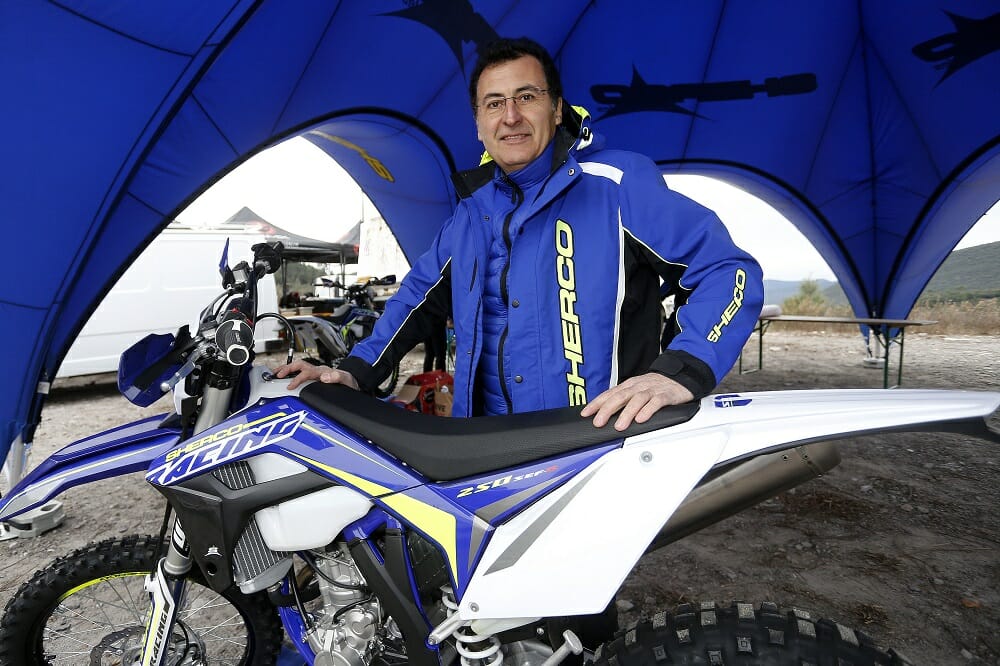 Marc Teissier is the man behind the French motorcycle company Sherco.
Marc Teissier is the man behind the French motorcycle company Sherco.
If you were a ’90s child, then there’s a strong possibility you will have owned a No Fear t-shirt with the slogan “It’s not the size of dog in the fight, but size of fight in the dog.” Being on the short side of average height I wore mine with pride until the print eventually faded out. It’s now 9.30am of a blustery cold Sunday morning in January 2017, and as I stand in an obscure French quarry prior to the start of the Alestrem Hard Enduro, that slogan pops into my head again.
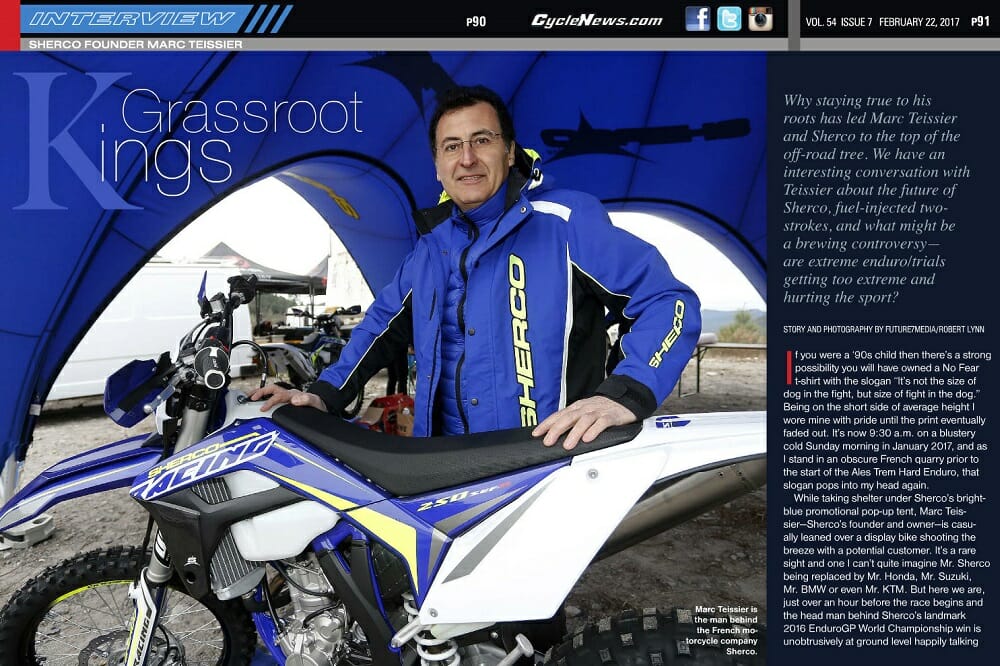
Story and Photography by Future7Media
While taking shelter under Sherco’s bright-blue promotional pop-up tent, Marc Teissier—Sherco’s founder and owner—is casually leaned over a display bike shooting the breeze with a potential customer. It’s a rare sight and one I can’t quite imagine Mr. Sherco being replaced by Mr. Honda, Mr. Suzuki, Mr. BMW or even Mr. KTM. But here we are, just over an hour before the race begins and the head man behind Sherco’s landmark 2016 EnduroGP World Championship win is unobtrusively at ground level happily talking bikes with punters. As I wait my turn to grab his attention I wonder if the prospective buyer even realizes exactly who he’s talking too.
Founded in 1998, Sherco’s rate of success has been rapid but understated. Trials first—that’s where Teissier’s first love lies—they built a solid customer base thanks to the success on the world stage with guys like Albert Cabestany and of course, Graham Jarvis, who also delivered a lot of success in the infamous Scottish Six Days Trial. Once they’d firmly established themselves there, next came enduro. Modest steps, highlighted by Jarvis winning the Red Bull Romaniacs for them in 2008, culminated in the 12-year process to becoming 2016 EnduroGP World Champions with Matt Phillips.
For a small, family run company 19 years in existence and selling a total of 6,000 motorcycles annually, it’s one heck of an achievement. Taking on and beating Goliath’s like KTM is something few predicted would happen preseason last year. But then again the beauty of unpredictability is why we run races.
As his customer begins to walk away, I step in with a courtesy handshake and chance my arm at asking the boss of Sherco for 20 minutes of his time. Met with a warming smile, his French switches to modest English and with no appointment needed I’m now sat in the passenger seat of his humble Audi out of the elements and talking bikes. No heirs or graces, it feels like simplistic grassroots stuff, the very philosophy I’m about to find out that his world beating company is built on.
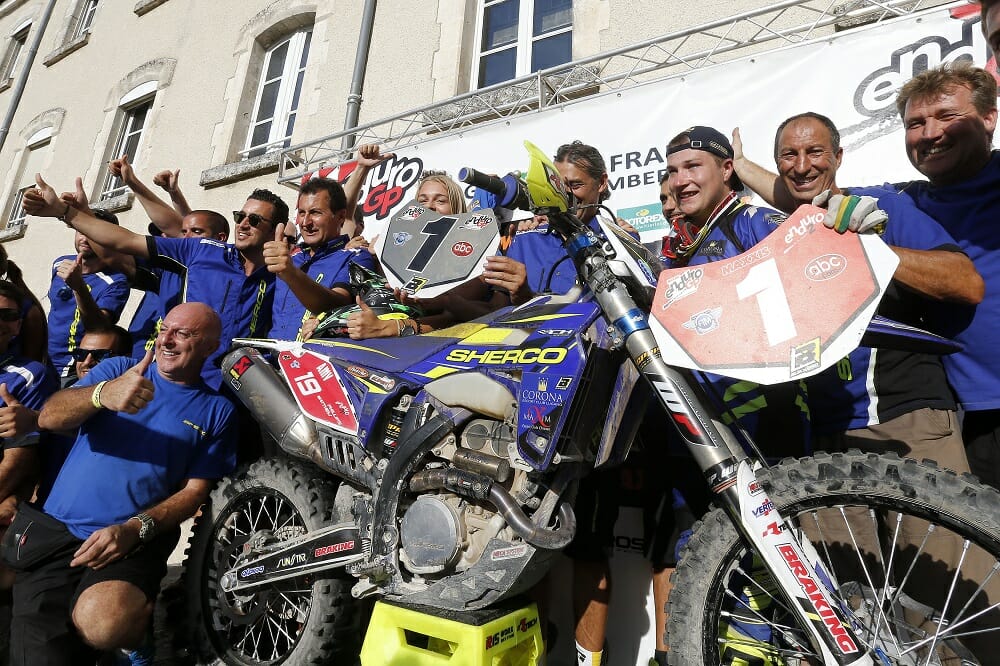 With Matthew Phillips at the controls, Sherco claimed its first FIM World Enduro Championship in 2016. A major accomplishment for such a small company.
With Matthew Phillips at the controls, Sherco claimed its first FIM World Enduro Championship in 2016. A major accomplishment for such a small company.
Forgive me for maybe stating the obvious here, but it’s a very rare sight to see the owner and founder of a world championship winning motorcycle manufacturer chatting with customers on a trade stand in the middle of a frosty-cold French quarry. In a sense it puts into perspective underneath the results just how much of a punch you guys are packing. Would you agree?
Yes, it’s true we are a little company but I feel a very dynamic one. Sherco is not a company with outside investment and capital—we’re not like that. We’re family funded and everything is done in small, calculated steps. We all get our hands dirty when needed. We originally started with trials, and when we added enduro we pushed steadily to understand that world, too. Now, after 12 years, we’re world champions and I think that’s a good step. When you see the competition we face—KTM, Husqvarna, Yamaha, Honda, Beta—it shows we can hold our own. I think that’s a that’s a strong statement to make.
Sherco returns from the Dakar Rally with another stage win and a strong showing. Although obviously competitive, why race Dakar? Is it for the publicity or development or success?
For us, rally has been a necessary step to take. All forms of competition is a good laboratory to test in and understand the engine and motorcycle. Dakar is the biggest testing ground of all. We used this year’s race as part of the development of the 450 and a new cylinder head—we tested many things in this Dakar. Yes, we won a stage, too, but overall we’re happy for the end result because we only used one engine for the race. And that has been one of the most positive things.
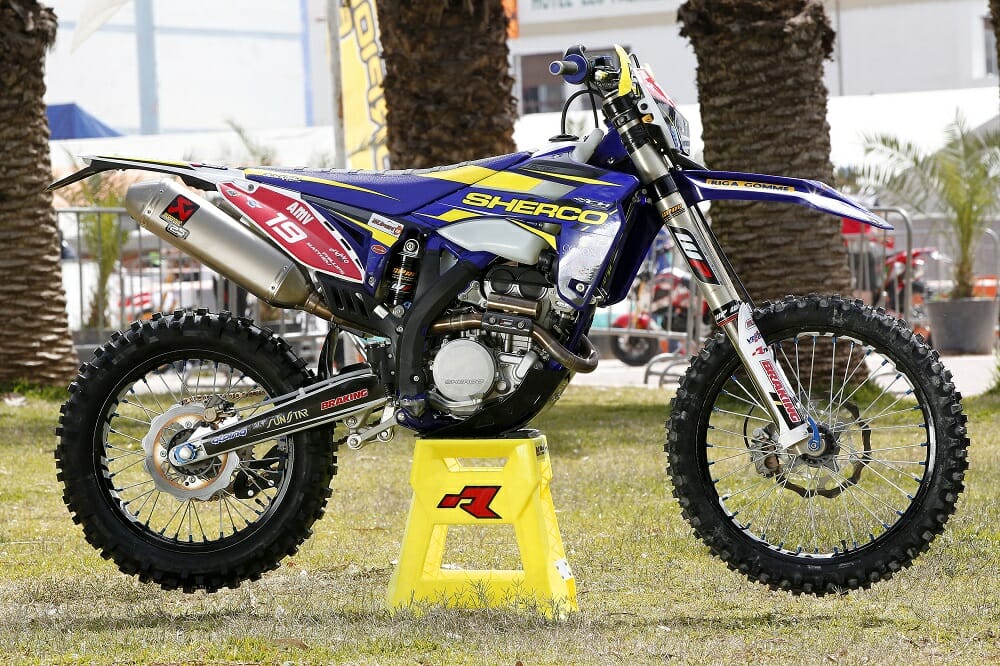 Phillips won the Enduro GP World Champion the Sherco 450 SEF-R Factory.
Phillips won the Enduro GP World Champion the Sherco 450 SEF-R Factory.
How big is Sherco and what is the company’s current business strategy?
We are not so big, but like I said we are dynamic. Our total sales figures are 6,000 units, trial and enduro combined. But there is possibility to increase. This is what we’ve been working on. We are pushing to increase our global distribution. We are opening to new markets—Australia, South America, North America—while also improving our existing sales, too.
We are now reaching the end of what will be our biggest expansion phase and that is having a complete range of motorcycles for the consumer to choose from. We launched our new 125cc two-stroke at the EICMA show in Milan last November and in a few months time it will be ready for market. Then we’re complete. It’s been a big investment to make—three models in both two-stroke and four-stroke enduro plus three models in trials—but we are now almost finished the process and it will be a good job.
Your heart and Sherco’s heart is very much in trials. But it also seems to be a sport in decline, especially at world championship level. For 2017, there is a new promoter and shakeup of the series, what advice would you offer on taking the sport forward?
I believe you need to remember the original roots of the sport. For me world trials competition is currently not a good promotion tool to sell my motorcycle and to sell the business. It’s too elitist. The level is now so high that it’s become difficult for the public to identify the sport with what guys like Toni Bou and Albert Cabestany are doing.
I think the new promoter wants to make a big show. But for me it’s important not to confuse sport with show—it’s also the same for extreme and enduro. Trials and extreme enduro are at the same sort of risk. In extreme, there are currently many riders competing but in 10 years time, if we keep making the rocks so big that only three people in the world can ride them, then people will say it’s no good.
I understand what people mean when they say, “look at F1 or MotoGP.” But F1 or MotoGP is only a laboratory or showcase for the pinnacle of the motor vehicle industry. There are just 20 motorcycles or cars on the track and all of them are prototypes. They are not available to the public—you can’t buy a F1 car to make sport at the weekend.
In trials we race the bike we sell, so for me it’s important that the normal guy can make at least 85 percent of the race. Okay, the final 10-15 percent maybe a dream or aspiration but it may also be potentially possible. I’ve spoken a lot with the promoters of EnduroGP and the FIM about this. I tell them “be careful, be careful.” For me it is necessary to pull back with trials and kill the high, high level, so the public can identify with the sport again.
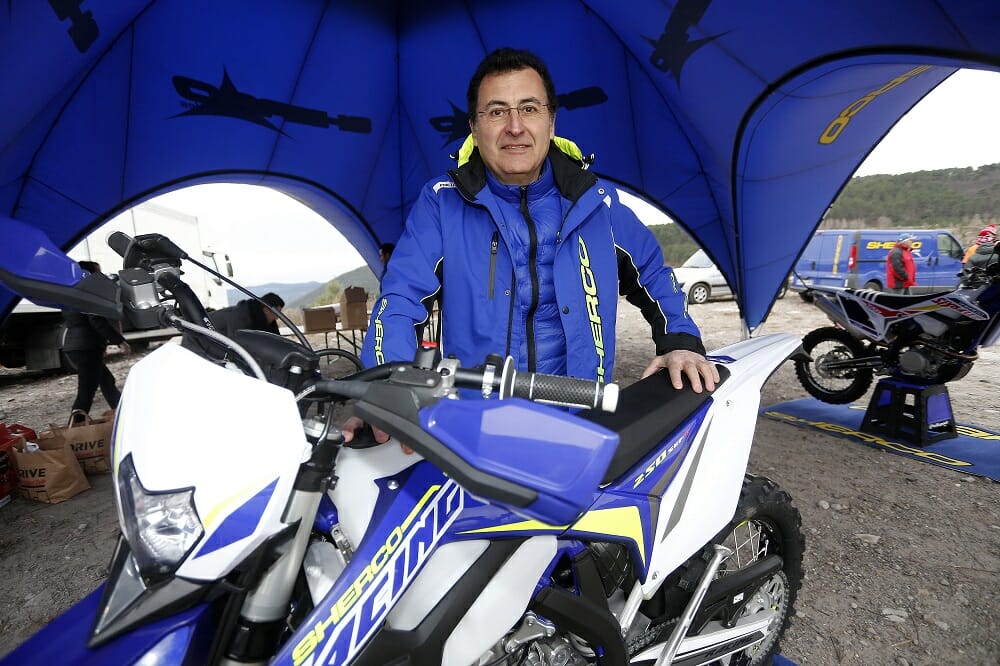 Teissier seems to understand the difference between the different needs of the high-end racers and the general off-road riding public.
Teissier seems to understand the difference between the different needs of the high-end racers and the general off-road riding public.
Similarly to trials, enduro is undergoing many changes for 2017. Now streamlined to two classes, where do you stand on it?
We are seeing many changes in EnduroGP. Some good, some not so good. It’s in a difficult period. With two classes for 2017, costs haven’t massively changed. The good riders have become more expensive maybe. Before we had six riders, now only two, but we still spend the same money to be sure of the best riders. I don’t know yet if it will be good for the sport. We had world champions in Enduro 1, Enduro 2, Enduro 3 and EnduroGP, now it’s only Enduro2 and EnduroGP. We have six enduro bikes and only two classes to race them in.
There are other complexities, too. Since money has come into the sport it’s now a business. We have a promoter to run the championship and of course he has to make money, too. But now we have to pay to park in the paddock, pay if you want to put up a tent for promotion, pay if you want to sell a sandwich. Making a third party video is also impossible. Like I said, we’re not F1 or MotoGP; enduro and trial is small there isn’t enough space to make it too professional, that’s not how this sport works.
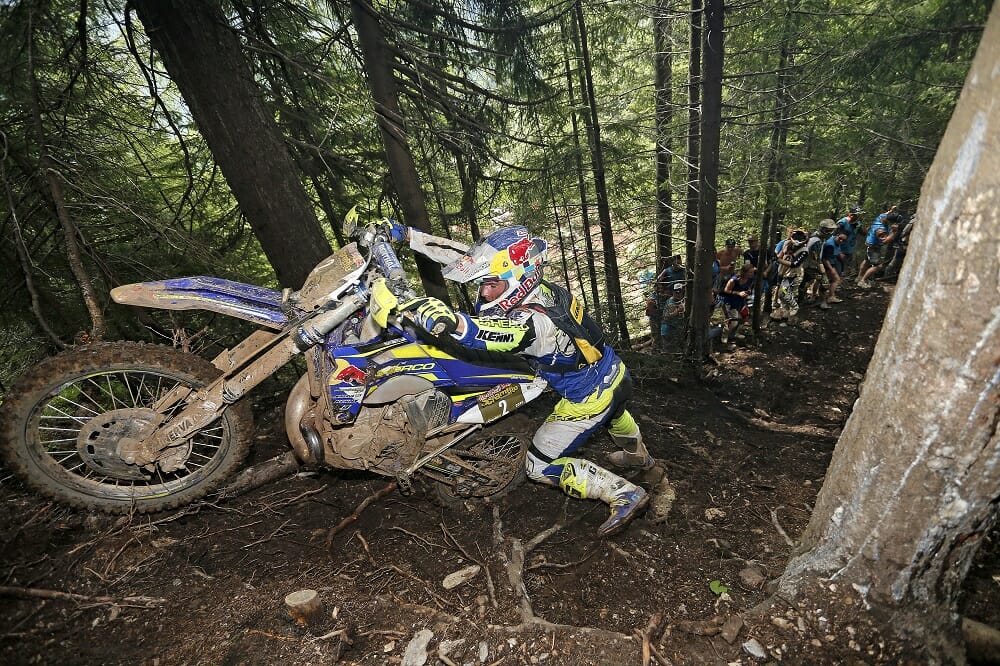 Teissier believes extreme off-road racing might not be the best thing for the sport.
Teissier believes extreme off-road racing might not be the best thing for the sport.
What is your philosophy on how the sport works?
My philosophy is that this sport is for the people by the people. It is the life of the rider, the sport, the factory, the motor club. If we become too elitist we are then trying to run a race for three riders and not 300 and this is no good.”
Like today at the Alestrem Extreme Enduro. We have 450 riders, including some of the best riders in the world here. That is fantastic to see. But we must also remember the race is for the majority—for the hobby guy. If the first lap is impossible, then the hobby guy goes home disappointed. He may not come back. They are the bloodline of our sport. They work all week and just want to play on their bike with their friends for one day. His Sunday is for fun. It’s a hobby he juggles with family life and if he can’t have fun then it is no good.
About three years ago Sherco released a video of their two-stroke fuel injection. Since then you’ve been quiet about it and now it looks like KTM will be the first to bring their system to market this year. When will you move to fuel injection?
Initially we were afraid of the EU homologation so that’s why we began to develop the fuel-injection system for two-strokes. But we also worked to find ways to keep the system we have and are now able to pass the Euro 4 homologation with the carburetor. And for me that is better. Carburetion is the two-stroke mentality. It has simplicity and ease of use and maintenance for the customer with less cost. Fuel injection will add an extra cost on the bike.
I don’t see the need to rush things right now. I feel we made that mistake by being the first four-stroke fuel-injected bike on the off-road market. It was all very new then and the customer was afraid of the changes. So this is why we wait a little. We have all the technology for the four-stroke, and now also for the two-stroke fuel injection but we wait. The bike is ready, the system is ready and we are ready, but it is not yet necessary to put it on the market.”
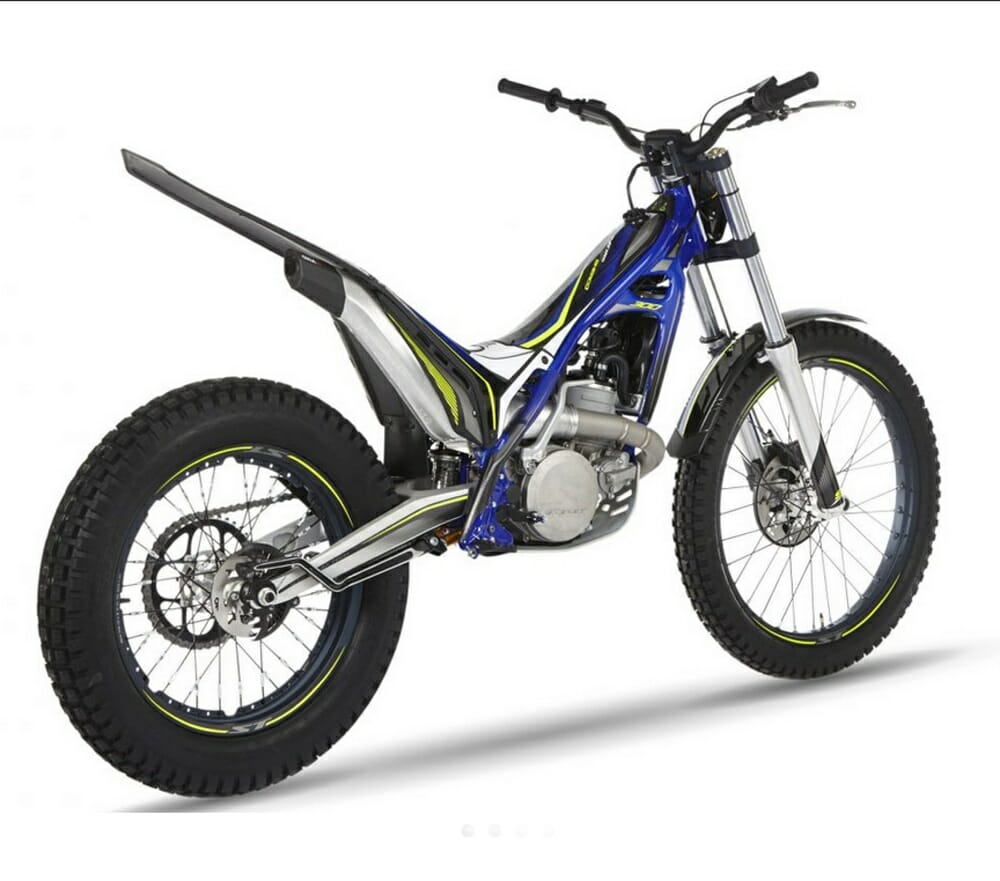 Sherco got started in trials and is still Teissier’s number-one passion.
Sherco got started in trials and is still Teissier’s number-one passion.
What are your thoughts on these European Union emission laws; are they too black and white without taking into account minorities like enduro or trials?
Politics doesn’t allow for discussion. Our voice isn’t heard and while they are pushing for cleaner air and emissions their decisions are stupid for minorities like us. We sell 6000 bikes, enduro is tiny and companies like Easyjet or Ryanair make more contamination with one flight than we will in a year. But I suppose this is the way it is.
And the future goals, as world champions, what’s next?
Next step? That is to finish the job. This year we will have all models so we want to make a good job with that before trying new things.”CN